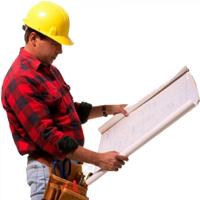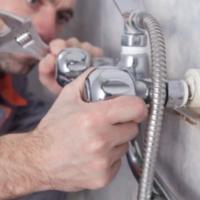How to Replace a Faucet
by Guest Post on Jan 12, 2010
Replacing an old or leaking faucet is not a difficult task and doesn’t require many tools. You will first need to select the right faucet replacement faucet, one that completely covers the mounting holes of the old faucet. The following steps will show you how to replace a faucet on a kitchen or bathroom sink.
How to Remove an Old Faucet:
Turn off the water supplyBoth hot and cold water valves located beneath the sink need to be shut off before you do any loosening of fittings. Turn on the faucet to drain away the remaining water and release any pressure.
Get proper tools
A monkey wrench or adjustable wrench is essential for the job. Because you will need to reach the fittings under the sink, a long basin wrench is also an important tool that allows you to grip the fitting at one end while turning the t-handle at the other.
Unscrew nuts and disconnect the faucet
Using the basin wrench, unscrew the nuts that attach the water supply hoses or pipes to the faucet and remove the hoses or pipes. Be careful not to unscrew the drain as well. Loosen the rest of the washers attaching the faucet to the sink. If the washers do not budge because of rust, apply penetrating oil to make the task easier. You can now remove the faucet from the sink.
Clean the area
To prepare the area for the new faucet, get rid of any buildup by dissolving it with a solution consisting of equal parts water and vinegar. Scrape the area clean with a putty knife or scouring pad.
How to Install a New Faucet:
Attach the faucet to the sink
Remove the washers on your new faucet and place them into the mounting holes at the top of the sink. Some faucets come with a gasket that serves as a seal between the faucet and the sink. Other faucets require the application of plumber’s putty around the faucet base to seal it onto the top of the sink. Under the sink, secure the faucet by placing the washers back on and tightening them by hand.
Connect to the water supply
Attach the water supply hoses to the faucet and then to the valves. Firmly tighten the nuts with the wrench, making sure that they are not over-tightened. Check that the hot and cold water supply valves are correctly fitted to the corresponding hoses leading to the faucet. Usually, the hot water is attached on the left and the cold water on the right.
Check for leaks
Turn the hot and cold water valves back on. Turn on the faucet to its full capacity and run the water for a few minutes to ensure there are no leaks. If you do see leakage, check all the connections and fittings and tighten them if necessary.
Popular Articles
Three Places to Spend Money on the Exterior of Your Home
When you have the exterior of your home remodeled, you are investing, time, energy and convenience into the project and you want to make sure that...
105550 Views
Homemade Headboards-Make an Upholstered or Wooden Headboard
Homemade headboards can add a lot of personality to any bedroom. They can be coordinated with existing furniture and room decor or they can be the...
80434 Views
When to Use a Brush, Roller or Sponge Brush
Brushes are a good choice for painting trim and woodwork. They are also useful for cutting in the edges around the top and bottom edges and corners...
73052 Views
Creating a Cottage Kitchen with Bead Board
Kitchen decor can range from modern and bold to elegant and elaborate by using strategic kitchen pieces. One of the most popular decorating trends...
58843 Views
Gas Fireplace Diagnostics and Troubleshooting
Follow these steps for diagnosing and troubleshooting Gas Fireplaces repairs. For the average DIYer, this may seem intimidating, depending on the...
35829 Views
Latest Articles
Why Professional Heat Pump Installation is Key to Maximizing Efficiency and Longevity
Heat pumps are a highly efficient means of heating and cooling homes, reducing energy costs and contributing to environmental sustainability. To...
on Dec 15, 2025
Hydro Jetting Services: Unclog Your Pipes with the Power of Water
When faced with stubborn clogs and slow drains, conventional solutions often fall short. But with the innovation of hydro jetting services,...
on Dec 15, 2025
Why Professional Boiler Repair is Essential for Home Safety and Comfort
Maintaining a warm and safe home environment is paramount for any homeowner. Your home's boiler system plays a critical role in this, but what...
on Nov 5, 2025
How to Keep Your Home Warm in the Winter
How to Keep Your Home Warm in the WinterAs winter approaches, keeping your home warm becomes a priority for comfort and health. Efficient heating...
on Oct 29, 2025
Why Reliable Furnace Repair is Essential for Winter Comfort
As the cold season approaches, homeowners recognize the critical role that a well-functioning furnace plays in ensuring a warm and cozy living...
on Oct 29, 2025
Featured Articles
What Type of Licensed Contractor Should You Hire?
on Feb 28, 2017
Hire Contractors / Estimates

Looking for a specialty project? There are many types of contractors available for your home improvement needs. Finding the right type of...
Actions
Top Categories
- Garden / Landscaping / Patio — 264
- Kitchen / Bathrooms — 240
- Real Estate / Finance — 203
- Appliance / Repair — 186
- Interior Design / Decor — 184
- HVAC / Air Conditioning — 150
- Cleaning / Maintenance — 144
- Improvements / Remodeling — 131
- Plumbing / Basements — 120
- Floors / Tile / Hardwood — 116
- Safety / Security — 114
- Doors / Garages — 113
Articles Archive
More DIY Articles
Cable Assembly Providers
Various types of wires and cables are used to construct all the machines and heavy equipment which are considered modern engineering marvels. Even...
5 Tips for Replacing Interior Doors
Have you ever thought about how much your interior doors impact the look and feel of your home? When you live in a place for long, the doors like...
How Safe is Glass Pool Fencing?
Pool fencing requirements and safety regulations are very stringent in many countries so it is important that the panels you use do comply with...
SOS! 5 Signs You Need Foundation Repair
Never put off needed foundation repair in Denver! The longer you ignore a cracked, weak foundation, the more damage it suffers as those cracks and...
Should I Repair or Replace My Appliances?
Is it worth fixing damaged refrigerators or should we go ahead and buy new ones? Will appliance service make a difference or are we just wasting...

